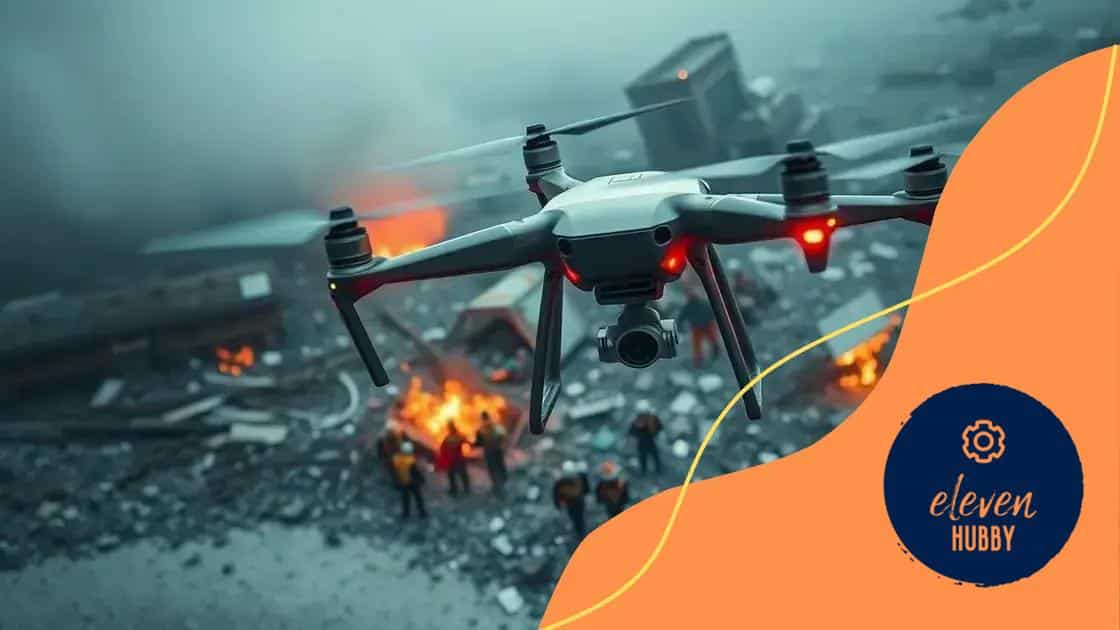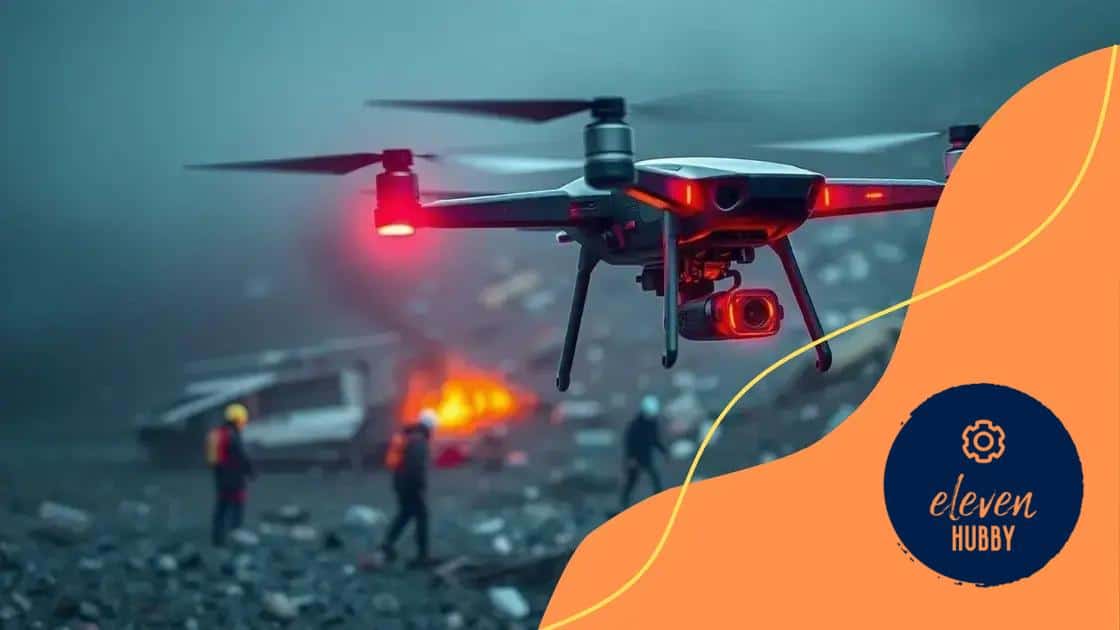How drones are revolutionizing disaster response efforts

How drones are revolutionizing disaster response efforts by providing real-time data, enhancing search and rescue operations, and improving situational awareness while overcoming challenges like environmental obstacles and limited battery life.
How drones are revolutionizing disaster response efforts is a game changer for emergency services. Imagine being able to assess damage and save lives in areas unreachable by traditional means. Today, we dive into how these flying helpers are making a real difference.
The role of drones in disaster assessment
In the realm of disaster response, drones play a vital role in assessment and analysis. They provide a bird’s-eye view of affected areas, allowing responders to gather critical information without putting themselves in harm’s way. This capability accelerates response times and enhances situational awareness.
Advantages of using drones for assessments
Drones offer several key benefits that revolutionize the way we approach disaster assessments:
- Real-time data: Drones can capture high-resolution images and videos, delivering immediate insights into the disaster zone.
- Access to difficult areas: They can reach locations that are unsafe or inaccessible for human responders.
- Cost-effective solutions: Using drones reduces the need for extensive ground teams, saving both time and resources.
- Safety improvements: By assessing damage from the air, drones help keep first responders out of hazardous environments.
As technology advances, the capabilities of drones continue to improve, making them even more effective in disaster assessment. For instance, equipped with thermal imaging or LiDAR, drones can detect heat signatures or create detailed topographical maps, providing deeper insights into the situation on the ground.
Additionally, data collected by drones can be easily shared with authorities and emergency management teams. This facilitates better coordination and planning among various response organizations. With the integration of geospatial data, responders can create more accurate maps of affected areas, which is essential for efficient resource allocation.
The use of drones is not limited to immediate assessments; they can also assist in ongoing monitoring of a disaster area. This continuous data collection helps in understanding how the situation evolves over time, which is critical for long-term recovery efforts.
In conclusion, the role of drones in disaster assessment cannot be overstated. Their ability to deliver real-time information, access hard-to-reach places, and enhance safety makes them indispensable tools in modern emergency response efforts.
Real-time data collection with drones
One of the most significant advantages of using drones in disaster response is their ability to perform real-time data collection. This capability allows emergency teams to understand the extent of damage swiftly and accurately. By flying over affected areas, drones can gather information that traditional methods might miss.
Benefits of real-time data collection
The benefits of real-time data collection with drones are numerous:
- Instant insights: Drones can transmit data and images back to command centers almost instantly, enabling quick decision-making.
- Accurate assessments: With high-resolution cameras, drones capture detailed visuals of the environment, allowing responders to assess damage more effectively.
- Less manpower required: Drones reduce the need for large teams in dangerous areas, keeping people safe while still gathering essential information.
- Before-and-after comparisons: Drones can monitor changes over time by capturing the same area multiple times, providing valuable insights into recovery and rebuilding efforts.
Additionally, drones equipped with advanced sensors can provide data on various factors, such as temperature variations and radiation levels. This information is crucial in understanding the full impact of a disaster and in planning appropriate responses.
The integration of real-time data collection techniques allows emergency teams to access the latest information as situations evolve. This leads to informed decisions and better resource allocation. For example, responders can quickly identify areas in dire need of assistance, ensuring that help reaches those most affected without delay.
Moreover, the use of drones enhances situational awareness. Responders can visualize active disaster scenes, making it easier to coordinate their efforts. This facilitates timely interventions and can ultimately save lives by ensuring that aid is delivered where it is needed most.
By continuously gathering data as the situation develops, drones play a critical role in the overall response strategy. They empower teams to adapt to changing conditions on the ground, making them invaluable tools in modern disaster response.
Drones for search and rescue operations

Drones are rapidly becoming essential tools in search and rescue operations. They can cover large areas quickly, which is vital in situations where every second counts. Equipped with advanced technology, drones assist rescuers by providing real-time visuals of the terrain.
Key roles of drones in rescue missions
Drones serve various purposes during search and rescue missions:
- Thermal imaging: Drones can be fitted with thermal cameras to detect heat signatures, making it easier to locate individuals in distress.
- Live streaming: Many drones can stream high-definition video to command centers, improving decision-making for rescue teams.
- Mapping: Drones create detailed maps of disaster areas, allowing responders to plan routes and allocate resources efficiently.
- Delivery systems: In some cases, drones can deliver supplies to stranded individuals before teams can reach them.
The ability of drones to access hard-to-reach areas is another significant advantage in rescue operations. For instance, during natural disasters like earthquakes or floods, traditional ground teams may find it challenging to navigate debris-filled environments. Drones fly over these obstacles, providing critical information and even aiding in the identification of safe zones. This capability greatly enhances the safety of rescue teams.
As technology advances, the functionality of drones continues to broaden. Some modern drones can perform autonomous flights, enabling them to cover designated areas without continuous human control. This feature allows teams to focus on other critical tasks while drones systematically search for signs of life.
Moreover, the integration of artificial intelligence in drones enhances their capabilities. AI can help in analyzing data from sensors and cameras, thus identifying potential locations of missing persons faster than human operators could. This rapid analysis can make a significant difference in life-and-death situations.
Countless success stories highlight the value of drones in search and rescue scenarios. From locating lost hikers to assisting in urban search and rescue after building collapses, drones are proving to be invaluable assets in emergency situations.
Challenges faced by drones in disaster zones
While drones have changed the landscape of disaster response, they still face numerous challenges in disaster zones. Understanding these challenges is essential for improving their effectiveness in emergencies.
Environmental obstacles
One major challenge is the environmental conditions present in disaster zones. Extreme weather, such as high winds, rain, and fog, can hinder a drone’s ability to fly safely and capture quality data. These conditions can lead to operational delays and limit the information available to rescue teams.
Technical limitations
Drones also have technical limitations that can affect their performance. Battery life is a significant concern. Many drones can only operate for 20 to 30 minutes at a time, which is often not enough to cover extensive disaster areas. Additionally, issues like GPS signal loss can prevent drones from navigating accurately in dense urban environments or mountainous regions.
- Signal interference: Natural disasters can disrupt communication signals, making it challenging for operators to control drones.
- Payload capacity: Most drones have limits on how much weight they can carry, restricting the type of sensors and equipment they can use.
- Data processing: The large volumes of data collected can overwhelm teams, requiring efficient systems for data analysis and sharing.
- Regulatory restrictions: Legal regulations can vary by region, which may limit drone operations during emergencies.
Another important factor is the need for skilled operators. Many emergency responders may not have extensive training in using drone technology, which can limit their effectiveness in urgent situations. Proper training and integration into existing teams are necessary for maximizing the potential of drones.
Despite these challenges, ongoing innovations in drone technology aim to address many of these issues. For instance, newer models are being designed with improved batteries and better weather resistance. Additionally, advancements in AI are helping drones to operate more autonomously, which can reduce the burden on human operators.
In the future, evolving drone capabilities combined with proper training and infrastructure will play a crucial role in overcoming these challenges and enhancing the effectiveness of drones in disaster response.
Future potential of drones in emergency management
The future potential of drones in emergency management is vast and promising. As technology continues to advance, drones are poised to become even more integral in disaster response and recovery efforts. These flying devices will offer innovative solutions to address challenges faced in today’s emergency situations.
Technological advancements
As drone technology evolves, we can expect enhancements that will improve functionalities significantly. For example, upcoming drones may have longer battery lives, enabling them to operate for extended missions without needing to recharge. This is crucial for covering larger areas in search and rescue operations, particularly in remote or difficult-to-access locations.
Integration with smart technology
Furthermore, the integration of drones with smart technology will open new avenues for analysis and decision-making. With artificial intelligence (AI) systems, drones will be able to process data in real-time and make autonomous decisions based on the information gathered. This capability can lead to faster responses and a more efficient allocation of resources during emergencies.
- Autonomous operations: Future drones may be capable of conducting missions without direct human control, enhancing their usability in critical situations.
- Collaboration with other technologies: Drones can be used alongside other tools, such as ground robots and satellites, to create a comprehensive monitoring system.
- Advanced data analytics: Incorporating advanced analytics will enable better prediction and planning for future emergencies, leading to improved preparedness.
- Public safety initiatives: Drones could be employed in educational campaigns to teach communities about disaster preparedness and response measures.
The potential uses of drones extend beyond immediate disaster response. They can play a vital role in post-disaster recovery by assessing damages and monitoring rebuilding efforts. Their ability to gather data over time will provide valuable insights into how areas recover and adapt, which is essential for future planning.
Moreover, there is a growing movement towards developing regulations that support the safe and responsible use of drones in emergency management. By establishing clear guidelines, agencies will encourage more widespread adoption of drone technology for public safety and community resilience.
With collaboration among governments, technology firms, and emergency responders, the role of drones in emergency management is likely to expand significantly. This evolution will not only enhance response capabilities but also save lives and resources, paving the way for a safer future.
In conclusion, drones are transforming disaster response and emergency management in remarkable ways. Their ability to quickly assess damage, gather real-time data, and assist in search and rescue operations saves lives and enhances safety. As technology continues to advance, the future of drones in this field looks even brighter. With improvements in battery life, AI integration, and regulatory support, drones will play an even more significant role in helping communities respond to and recover from disasters.
FAQ – Frequently Asked Questions about Drones in Disaster Response
How do drones help in search and rescue operations?
Drones can quickly cover large areas, providing real-time visuals and thermal imaging to help locate missing individuals.
What are the benefits of using drones for data collection during emergencies?
Drones gather instant data that improves decision-making, enhances situational awareness, and can operate in hazardous conditions without putting human lives at risk.
What challenges do drones face in disaster zones?
Drones face challenges like environmental obstacles, limited battery life, signal interference, and the need for skilled operators to navigate effectively.
What is the future potential of drones in emergency management?
The future looks promising, with advancements in drone technology like longer battery life, AI integration, and better regulations enabling safer and more efficient operations.






